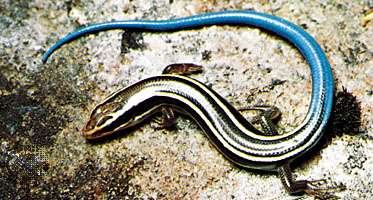Skinks of India

What are skinks?
- Skink, (family Scincidae), are a group of lizards, mostly secretive ground dwellers or burrowers, that are represented throughout most of the world but are especially diverse in Southeast Asia and its associated islands, the deserts of Australia, and the temperate regions of North America.
- Their body is typically cylindrical in cross-section, and most species have cone-shaped heads and long, tapering tails. They may have either shrunken limbs or no limbs. Their bodies have scales.
- They are highly alert, agile and fast-moving and actively forage for a variety of insects and small invertebrates.
- Some species lay eggs, while others give birth to fully developed young.
- Being void of legs or shorter legs, these are confused with snakes and are killed predicting to be venomous. They are not venomous creatures.
Why in the News?
- The Zoological Survey of India (ZSI) has released a report called ‘Skinks in India’. It is the first monograph released on this group of lizards.
- The report makes an attempt to ‘redescribe’ all the 62 species with their taxonomic identification keys, distributional maps, habits, habitat and breeding biology etc.
What does the report say?
- The report reveals that India is home to 62 species of skinks and says about 57% of all the skinks found in India (33 species) are endemic (found in only that habitat or place).
- Some of the endemic species are :
- Barkudia insularisis believed to be found only in the Barkud Island in Chilka lake in Odisha.
- Barkudia melanosticta is endemic to Visakhapatnam.
- Sepsophis punctatus is endemic to the northern part of Eastern Ghats.
- Five species of Kaestlea (blue-tailed ground skinks) are endemic to the Western Ghats.
- Four species of Ristella (Cat skinks) are also endemic to the southern part of Western Ghats.
- It gives a phylogenetic and biogeographical analysis of distribution of these species in all the 11 bio-geographic zones of India.
Reference:
Subscribe
Login
0 Comments
